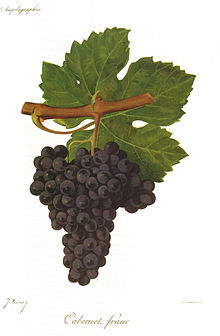Cabernet Franc
| Cabernet Franc | |
|---|---|
| Grape (Vitis) | |
 Cabernet Franc in Viala & Vermorel | |
| Color of berry skin | Blue-black |
| Species | Vitis vinifera |
| Also called | Bouchet, Bouchy, Breton (more) |
| Origin | Bordeaux, France |
| Notable regions | Bordeaux, Loire |
| Notable wines | Château Cheval Blanc |
| VIVC number | 1927 |
Cabernet Franc is one of the major black
Cabernet Franc is lighter than Cabernet Sauvignon,.
Records of Cabernet Franc in Bordeaux go back to the end of the 18th century, although it was planted in Loire long before that time. DNA analysis indicates that Cabernet Franc is one of two parents of Cabernet Sauvignon, Merlot, and Carménère.[3]
History

Cabernet Franc is believed to have been established in the
Viticulture

In general, Cabernet Franc is very similar to Cabernet Sauvignon, but
Cabernet Franc can adapt to a wide variety of
Wine regions
Across the world Cabernet Franc is one of the twenty most widely planted
France
In France, Cabernet Franc is found predominantly in the Loire Valley and in the Libournais region of Bordeaux. As of 2000, it was the sixth most widely planted red grape variety in the country. Other areas with significant plantings include the
In the Loire Valley, Cabernet is widely planted in the
Italy
By 2000 there were over 17,300 acres (7,000 ha) of Cabernet Franc in Italy. However, the grape variety is commonly confused with both Cabernet Sauvignon and the ancient Bordeaux grape

Hungary
Cabernet Franc in
In addition to being found in Villány and Szekszárd, Cabernet Franc is also present in Eger, and in South Balaton and Sopron vineyards, to a lesser extent. Cabernet Franc often complements Bordeaux-style blends from these regions and occasionally plays a role in rosé production.
Other European regions
Outside France and Italy, sizable plantings of Cabernet Franc are found in Greece (where it is known as tsapournakos),
. It is also grown Valencia and Castilla-La Mancha. In 2015, Spain grew 732 hectares (1,809 acres) of Cabernet Franc.Canada
Cabernet Franc is becoming more popular in Canada, being planted in
United States

Interest in the grape started with
More recently the grape has caught the attention of growers in cooler areas such as
In Washington State, the first plantings of Cabernet Franc were cultivated in experimental blocks by
Argentina
Cabernet Franc plantings in
Other New World regions

In the New World, Cabernet is used predominantly as a blending component and is found in scant amounts in
Wines

Cabernet Franc shares many of the same
Synonyms
Genetically verified: Tsapournako (Greece), Verdejilla Tinto (Aragón in Spain).[11]
Other synonyms: Achéria (Basque Country, mainly in Irouléguy), Ardounet (Béarn), Bidure (Graves), Bordeaux (Switzerland), Bordo (Romania), Boubet (Pyrénées-Atlantiques), Bouchet Franc or Gros Bouchet (Saint-Émilion and Pomerol), Bouchy (Madiran and Béarn), Breton (Val de Loire), Cabernet Gris, Cabrunet (Pomerol), Capbreton Rouge (Landes), Carmenet (Médoc), Couahort (Béarn), Plant Breton or Plant de l’Abbé Breton (Chinon in Indre-et-Loire), Sable Rouge (Tursan), Trouchet (Béarn), Véron (Nièvre and Deux-Sèvres), Vidure, Vuidure, Grosse Vidure (Graves),[11] Aceria, Arrouya, Burdeas Tinto, Cabernet, Cabernet Aunis, Cabernet Franco, Fer Servandou, Gamput, Grosse Vidure, Hartling, Kaberne Fran, Messanges Rouge, Morenoa, Noir Dur, Petit Fer, Petit Viodure, Petite Vidure, Petite Vignedure, Véron Bouchy, Véronais.[12]
Varieties commonly mistaken for Cabernet franc:
References
- ^ "Discovery Channel: "DNA analysis reveals mysterious past of Cabernet Sauvignon"". Archived from the original on 2008-03-08. Retrieved 2006-11-05.
- ^ a b "Cabernet Franc". www.winepros.org. Archived from the original on 2018-09-28. Retrieved 2007-03-23.
- ISBN 9780141968827– via Google Books.
- ^ ISBN 0-19-860990-6
- ^ ISBN 0-15-100714-4
- ^ a b Radden, Rosemary. "Grapes and Wines of the World". The State Library of South Australia, GPO Box 419, Adelaide SA 5001. Archived from the original on 2007-08-07. Retrieved 2007-05-05.
- ISBN 0-520-24869-4
- ^ a b Argentina 2016 Special Report, by Tim Atkin MW
- ^ Discovering the dark horse of Argentine wine Archived 2018-03-23 at the Wayback Machine Squeeze Magazine
- ^ Wines of Chile http://www.winesofchile.org/wp/the-wines/wine-varieties/hectares-planted/ Archived 2015-12-10 at the Wayback Machine
- ^ ISBN 978-1-846-14446-2.
- ^ Maul, E.; Eibach, R. (June 1999). "Vitis International Variety Catalogue". Information and Coordination Centre for Biological Diversity (IBV) of the Federal Agency for Agriculture and Food (BLE), Deichmanns Aue 29, 53179 Bonn, Germany. Archived from the original on 2007-04-11. Retrieved 2007-05-06.
